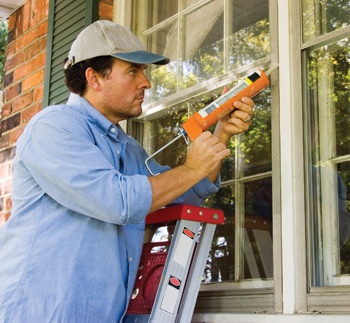Every article about saving energy tells you that caulking around windows and doors is the simplest way to keep air from leaking into and out of your home.
That’s only true, of course, if you know how to do it correctly. Here are some simple instructions for using caulk around your home to keep your expensive air-conditioned or heated air indoors where it belongs—and the outdoor weather outside.
1. Choose the caulk.
Caulk is a flexible sealer made from silicone or paintable acrylic latex that you can work into cracks and gaps around your house to fill them in and prevent air from leaking through them into or out of the building. You’ll find it at the hardware store in a plastic or cardboard tube or cartridge. If you want to paint the caulk to match your window frames, buy a type that’s paintable. If you want to caulk less often, silicone might be a better choice, as it’s less prone to cracking. It’s not paintable, but it comes in a variety of colors. You’ll use about a half cartridge on a typical-sized window.
2. Use a caulking gun.
Applying caulk directly from the tube is a headache unless you’re just filling in a tiny area. You can buy a caulking gun at a hardware or paint store for less than $15.
3. Decide where you will caulk.
Any hole, gap, crack or opening on the inside or outside of your house needs caulking. The biggest gaps often are around windows and doors. Seal gaps and cracks around exterior light fixtures, outdoor taps, openings for exhaust fans and places where cable and phone lines pierce the wall.
4. Prepare the surface.
Clean and dry the area you will caulk. You will apply the caulk between the window frame and the stucco or siding on the outside of your house or at the joint between the frame and the drywall indoors. Scrape away any old caulk and loose paint, and scrub off dirt from that area. Allow the surface to dry thoroughly before caulking.
5. Load your caulking gun.
Slide the tube of caulk into the caulking gun. Snip the tip off of the tube, making as small a hole as possible so you can control the amount of caulk that squeezes out of it. Secure the tube snugly into the gun.
6. Apply the caulk.
Hold the gun at a 45-degree angle and squeeze a small bead of caulk into the tiny line that separates the window frame from the stucco, brick or siding. Use your finger (you may want to wear thin rubber gloves) to carefully smooth the caulk into that tiny opening. Repeat the process until you have caulked all the way around the window frame.
7. Let it dry.
Allow the caulk to set for 24 hours before painting it to match your window frame.
8. Don’t stop now.
Repeat the process on any gap or crack that exposes your home to the outdoor weather. You’ll save more on your energy bill than you spent on the caulk and caulking gun.

